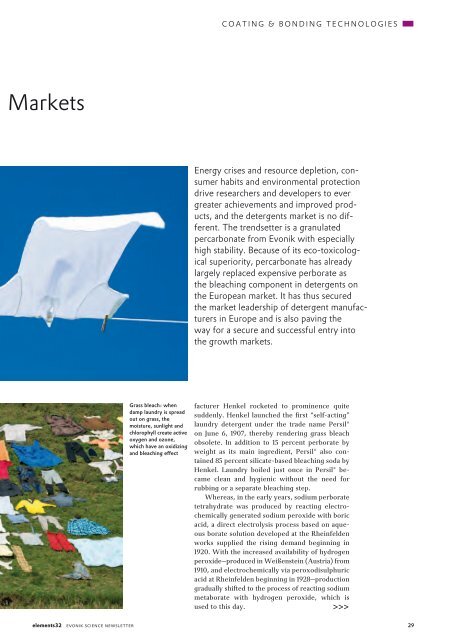Download - Evonik Industries
Download - Evonik Industries
Download - Evonik Industries
Create successful ePaper yourself
Turn your PDF publications into a flip-book with our unique Google optimized e-Paper software.
Markets<br />
elements32 evonik science newsletter<br />
Grass bleach: when<br />
damp laundry is spread<br />
out on grass, the<br />
moisture, sunlight and<br />
chlorophyll create active<br />
oxygen and ozone,<br />
which have an oxidizing<br />
and bleaching effect<br />
c o A t i n G & B o n D i n G t e c H n o l o G i e S<br />
energy crises and resource depletion, consumer<br />
habits and environmental protection<br />
drive researchers and developers to ever<br />
greater achievements and improved products,<br />
and the detergents market is no different.<br />
the trendsetter is a granulated<br />
percarbonate from evonik with especially<br />
high stability. Because of its ecotoxicolo gical<br />
superiority, percarbonate has already<br />
largely replaced expensive perborate as<br />
the bleaching component in detergents on<br />
the european market. it has thus secured<br />
the market leadership of detergent manufacturers<br />
in europe and is also paving the<br />
way for a secure and successful entry into<br />
the growth markets.<br />
facturer Henkel rocketed to prominence quite<br />
suddenly. Henkel launched the first “self-acting”<br />
laundry detergent under the trade name Persil®<br />
on June 6, 1907, thereby rendering grass bleach<br />
obsolete. In addition to 15 percent perborate by<br />
weight as its main ingredient, Persil® also contained<br />
85 percent silicate-based bleaching soda by<br />
Henkel. Laundry boiled just once in Persil® became<br />
clean and hygienic without the need for<br />
rubbing or a separate bleaching step.<br />
Whereas, in the early years, sodium perbo rate<br />
tetrahydrate was produced by reacting electrochemically<br />
generated sodium peroxide with boric<br />
acid, a direct electrolysis process based on aqueous<br />
borate solution developed at the Rheinfelden<br />
works supplied the rising demand beginning in<br />
1920. With the increased availability of hydrogen<br />
peroxide—produced in Weißenstein (Austria) from<br />
1910, and electrochemically via peroxodisulphuric<br />
acid at Rheinfelden beginning in 1928—production<br />
gradually shifted to the process of reacting sodium<br />
metaborate with hydrogen peroxide, which is<br />
used to this day. >>><br />
29

















